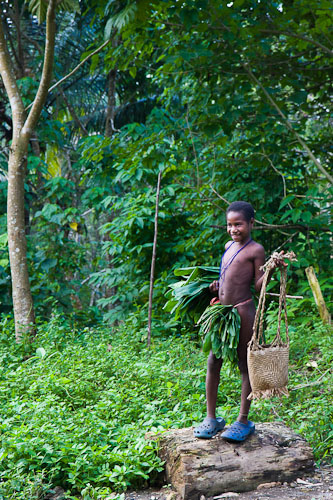Espiritu Santo
As if the stunning hospitality and well-preserved tribal traditions weren’t impressive enough in the rest of the country, here on Vanuatu‘s largest island they reach proportions that stagger belief. The dense, jungley mountain slopes of the interior, which include the country’s four highest peaks, are home to dozens of villages where people wear only traditional tribal dress every day, have not been converted to Christianity and whose children to do not go to school. Their extreme kindness, helpfulness, warmth and hospitality is simply put, unlike anything I have encountered anywhere else in the world. Add into the equation two of the world’s most beautiful beaches which you are more than likely to have all to yourself and, although nowhere is paradise, this is probably as close to it as you can get on Earth.
Photo by Elyse Patten.
When Vanuatu achieved its independence in 1980 under the Vanu’aka party led by the new Prime Minister Bishop Walter Lini, a man called Jimmy Stevens on Espiritu Santo organised what became known as the Coconut Rebellion and declared the island’s independence as the nation of “Vemarana”. Many tribesmen came out of the interior armed with bows and arrows to support Stevens who, as those tribesmen believe to this day, was defending Kastom against the ever-increasing rule of the Christian church. Stevens is quoted as having said, “time is not important here… We want to be free to make our own decisions, to run our own economy and have a picnic when we feel like having one.” This ties in very much with the attitude of the tribesmen of interior Santo, who work only a few hours a day in the jungle to meet their food requirements and spend the rest of their time relaxing with their family and friends and drinking kava!
Bishop Walter Lini applied for help from Britain and France in crushing the rebellion but France, who it later turned out was supporting Stevens, refused to allow Britain to bring in troops. Papua New Guinea however answered Walter Lini’s call for troops and after the death of his son Stevens surrendered and was imprisoned. Many of the tribesmen who had supported Stevens retreated back into the jungle where they reside to this day.
A dirt track runs along Espiritu Santo’s south coast and similarly up its east coast and along the eastern half of the north coast. The centre, the west coast and the Cumberland Peninsula jutting out to the north are entirely without roads.
Even a one hour trek away from the coastal roads, particularly the south coast one, will bring you to villages where men wear loincloths and women wear only two leafy branches tucked into a string belt, one at the front and one at the back, as the girl in the photo above is wearing. Most men’s loincloths are made from cloth that they buy on occasional visits to Luganville, Espiritu Santo’s capital (population 13,000), but in the very centre of the island there are people who only wear loincloths made from tree bark and who very rarely leave the area immediately surrounding their village. The men speak Bislama but many women and children don’t. Getting there is a two-day trek from the coast.
Luganville, being Vanuatu‘s second largest town and having the country’s second international airport, also has services catering to the more conventional traveler – car hire, diving trips to the wreck of the HMS Coolidge (one of the world’s best wreck dives) and tours to a huge cave, a blue hole in the jungle and of course the beaches, which can also be reched independently by traveling up the east-coast road.
There are a few international flights to Espiritu Santo from nearby countries and internal flights to many other islands. There are also boats to Pentecost, Malekula, Epi, Port Vila and Ambrym. Ask at the docks in Luganville.
Click here for my 5995 word blog about Espiritu Santo.

Leave a Reply